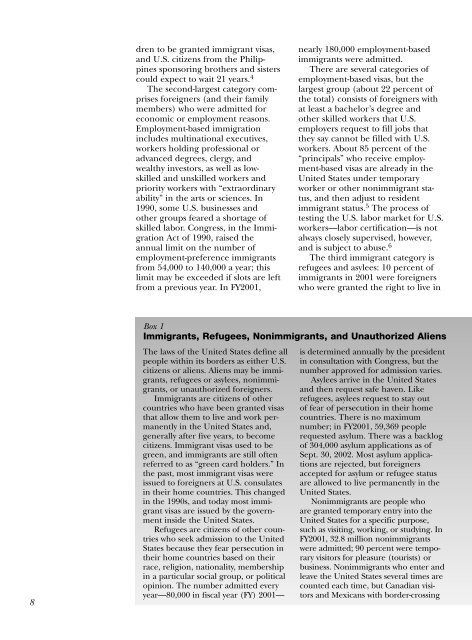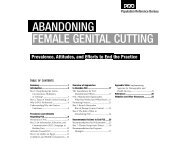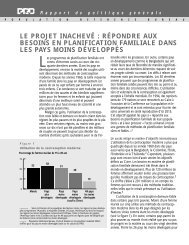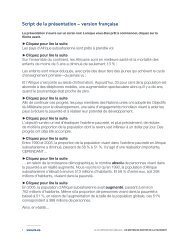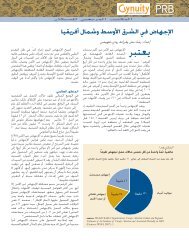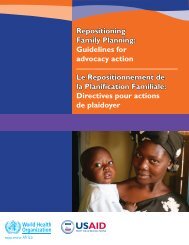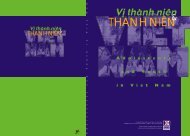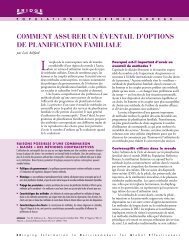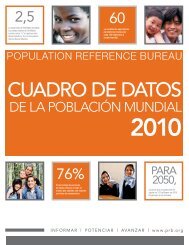Immigration Shaping America - Population Reference Bureau
Immigration Shaping America - Population Reference Bureau
Immigration Shaping America - Population Reference Bureau
You also want an ePaper? Increase the reach of your titles
YUMPU automatically turns print PDFs into web optimized ePapers that Google loves.
dren to be granted immigrant visas,<br />
and U.S. citizens from the Philippines<br />
sponsoring brothers and sisters<br />
could expect to wait 21 years. 4<br />
The second-largest category comprises<br />
foreigners (and their family<br />
members) who were admitted for<br />
economic or employment reasons.<br />
Employment-based immigration<br />
includes multinational executives,<br />
workers holding professional or<br />
advanced degrees, clergy, and<br />
wealthy investors, as well as lowskilled<br />
and unskilled workers and<br />
priority workers with “extraordinary<br />
ability” in the arts or sciences. In<br />
1990, some U.S. businesses and<br />
other groups feared a shortage of<br />
skilled labor. Congress, in the <strong>Immigration</strong><br />
Act of 1990, raised the<br />
annual limit on the number of<br />
employment-preference immigrants<br />
from 54,000 to 140,000 a year; this<br />
limit may be exceeded if slots are left<br />
from a previous year. In FY2001,<br />
nearly 180,000 employment-based<br />
immigrants were admitted.<br />
There are several categories of<br />
employment-based visas, but the<br />
largest group (about 22 percent of<br />
the total) consists of foreigners with<br />
at least a bachelor’s degree and<br />
other skilled workers that U.S.<br />
employers request to fill jobs that<br />
they say cannot be filled with U.S.<br />
workers. About 85 percent of the<br />
“principals” who receive employment-based<br />
visas are already in the<br />
United States under temporary<br />
worker or other nonimmigrant status,<br />
and then adjust to resident<br />
immigrant status. 5 The process of<br />
testing the U.S. labor market for U.S.<br />
workers—labor certification—is not<br />
always closely supervised, however,<br />
and is subject to abuse. 6<br />
The third immigrant category is<br />
refugees and asylees: 10 percent of<br />
immigrants in 2001 were foreigners<br />
who were granted the right to live in<br />
8<br />
Box 1<br />
Immigrants, Refugees, Nonimmigrants, and Unauthorized Aliens<br />
The laws of the United States define all<br />
people within its borders as either U.S.<br />
citizens or aliens. Aliens may be immigrants,<br />
refugees or asylees, nonimmigrants,<br />
or unauthorized foreigners.<br />
Immigrants are citizens of other<br />
countries who have been granted visas<br />
that allow them to live and work permanently<br />
in the United States and,<br />
generally after five years, to become<br />
citizens. Immigrant visas used to be<br />
green, and immigrants are still often<br />
referred to as “green card holders.” In<br />
the past, most immigrant visas were<br />
issued to foreigners at U.S. consulates<br />
in their home countries. This changed<br />
in the 1990s, and today most immigrant<br />
visas are issued by the government<br />
inside the United States.<br />
Refugees are citizens of other countries<br />
who seek admission to the United<br />
States because they fear persecution in<br />
their home countries based on their<br />
race, religion, nationality, membership<br />
in a particular social group, or political<br />
opinion. The number admitted every<br />
year—80,000 in fiscal year (FY) 2001—<br />
is determined annually by the president<br />
in consultation with Congress, but the<br />
number approved for admission varies.<br />
Asylees arrive in the United States<br />
and then request safe haven. Like<br />
refugees, asylees request to stay out<br />
of fear of persecution in their home<br />
countries. There is no maximum<br />
number; in FY2001, 59,369 people<br />
requested asylum. There was a backlog<br />
of 304,000 asylum applications as of<br />
Sept. 30, 2002. Most asylum applications<br />
are rejected, but foreigners<br />
accepted for asylum or refugee status<br />
are allowed to live permanently in the<br />
United States.<br />
Nonimmigrants are people who<br />
are granted temporary entry into the<br />
United States for a specific purpose,<br />
such as visiting, working, or studying. In<br />
FY2001, 32.8 million nonimmigrants<br />
were admitted; 90 percent were temporary<br />
visitors for pleasure (tourists) or<br />
business. Nonimmigrants who enter and<br />
leave the United States several times are<br />
counted each time, but Canadian visitors<br />
and Mexicans with border-crossing


